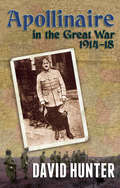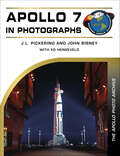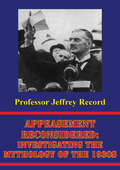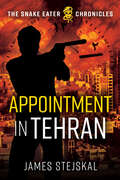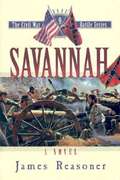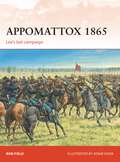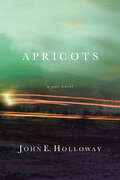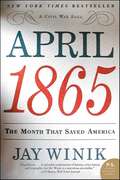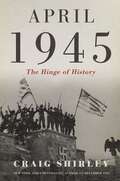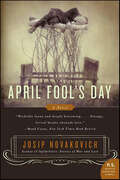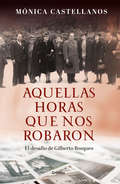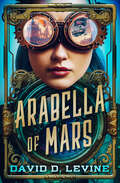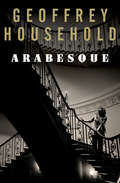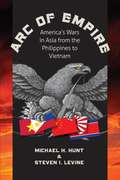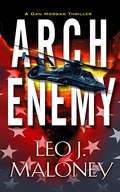- Table View
- List View
Apollinaire in the Great War (1914-18)
by David HunterA major literary figure in pre-war Paris, Guillaume Apollinaire volunteered for war in 1914, trained as an artilleryman and was posted in April 1915 to the Champagne front in northern France, participating in the bloody but little-known offensive that September and then moving into the front line as an infantry officer, before being wounded in March 1916 and invalided out of active service. Back in Paris, Apollinaire plunged back into the activities of the capital's artistic avant-garde, meanwhile publishing poetry, prose and plays that were deeply influenced by his involvement in the conflict. He died on 9 November 1918, two days before the Armistice, a victim of the influenza pandemic, but with a literary reputation secured, as well as a certain fame for coining the term 'Surrealism'. This book draws heavily on Apollinaire's writings to tell the story of his war years, within the wider context of the French experience of the Great War. In this period, Apollinaire also wrote hundreds of letters, the bulk of them to two women: Louise de Coligny, a flighty socialite of aristocratic origin, and Madeleine Pagès, a young schoolteacher. In these letters he poured out his passionate feelings for both in often highly erotic poetry and prose, as well as giving detailed descriptions of his life as a front-line soldier.
Apollo 1 in Photographs: The Apollo Photo Archive
by John Bisney J. L. Pickering Ed HengeveldThe Project Apollo in Photographs series features tens of thousands of previously unpublished images from the J.L. Pickering collection.
Apollo 7 in Photographs: The Apollo Photo Archive
by John Bisney J. L. Pickering Ed HengeveldThe Apollo Photo Archive series comprises the most comprehensive pictorial record of America&’s moon-landing program ever published. The series continues with Apollo 7&’s launch in October 1968. Crewed by Wally Schirra, Donn Eisele, and Walt Cunningham, it was the first successful Apollo space flight. Less than two years after the Apollo 1 disaster in January 1967, the success of Apollo 7 helped redirect the course of the Apollo program and, therefore, space history. Readers will enjoy more than 700 photos, which feature the arrival and assembly of the rocket and spacecraft, crew selection and training, preflight activities, mission countdown, launch, the flight itself, splashdown, and subsequent crew appearances and related activities.
Appeasement Reconsidered: Investigating The Mythology Of The 1930s
by Professor Jeffrey RecordThe appeasement of Nazi Germany by the western democracies during the 1930s and the subsequent outbreak of World War II have been a major referent experience for U.S. foreign policymakers since 1945. From Harry Truman's response to the outbreak of the Korean War to George W. Bush's decision to overthrow Saddam Hussein, American presidents have repeatedly affirmed the "lesson" of Munich and invoked it to justify actual or threatened uses of force. However, the conclusion that the democracies could easily have stopped Hitler before he plunged the world into war and holocaust, but lacked the will to do so, does not survive serious scrutiny. Appeasement proved to be a horribly misguided policy against Hitler, but this conclusion is clear only in hindsight - i.e., through the lens of subsequent events.Dr. Jeffrey Record takes a fresh look at appeasement within the context of the political and military environments in which British and French leaders operated during the 1930s. He examines the nature of appeasement, the factors underlying Anglo-French policies toward Hitler from 1933 to 1939, and the reasons for the failure of those policies. He finds that Anglo-French security choices were neither simple nor obvious, that hindsight has distorted judgments on those choices, that Hitler remains without equal as a state threat, and that invocations of the Munich analogy should always be closely examined.
Appeasement: Chamberlain, Hitler, Churchill, and the Road to War
by Tim BouverieA NEW YORK TIMES EDITORS&’ CHOICE • SUNDAY TIMES (UK) BESTSELLER • A gripping history of the British appeasement of Hitler on the eve of World War II&“An eye-opening narrative that makes for exciting but at times uncomfortable reading as one reflects on possible lessons for the present.&”—Antonia Fraser, author of Mary Queen of ScotsOn a wet afternoon in September 1938, Prime Minister Neville Chamberlain stepped off an airplane and announced that his visit to Hitler had averted the greatest crisis in recent memory. It was, he later assured the crowd in Downing Street, "peace for our time." Less than a year later, Germany invaded Poland and the Second World War began.Appeasement is a groundbreaking history of the disastrous years of indecision, failed diplomacy and parliamentary infighting that enabled Hitler's domination of Europe. Drawing on deep archival research and sources not previously seen by historians, Tim Bouverie has created an unforgettable portrait of the ministers, aristocrats, and amateur diplomats who, through their actions and inaction, shaped their country's policy and determined the fate of Europe. Beginning with the advent of Hitler in 1933, we embark on a fascinating journey from the early days of the Third Reich to the beaches of Dunkirk. Bouverie takes us not only into the backrooms of Parliament and 10 Downing Street but also into the drawing rooms and dining clubs of fading imperial Britain, where Hitler enjoyed surprising support among the ruling class and even some members of the royal family. Both sweeping and intimate, Appeasement is not only an eye-opening history but a timeless lesson on the challenges of standing up to aggression and authoritarianism--and the calamity that results from failing to do so.
Appointment in Tehran: A Cold War Spy Thriller (The Snake Eater Chronicles Series #2)
by James StejskalWhen radical Iranian students seize the U.S. Embassy compound in Tehran and take over fifty diplomats hostage the U.S. President has to negotiate with a government that wants only to humiliate the United States. When talks fail, the President must turn to the military to bring the Americans home by force. As preparations are made for an audacious rescue, an American intelligence officer hides alone in a Tehran safehouse with a secret. He is protecting a powerful weapon known as the Perses Device, which is now at risk of being captured and employed against the United States. The Agency Director orders that it must be brought out at all costs. But as a small American team clandestinely enters Tehran to lead the way for the rescue force, a traitor spills the secret and KGB Spetsnaz operatives begin their own search for the weapon. At the last minute, one more American is added to the advance team—his sole mission is to get the Agency officer and the Perses device to safety. When the rescue mission fails, only two Americans are left to run the gauntlet of enemy agents and get the weapon out. Getting in was easy…
Appomattox (The Civil War Battle Series, Book #10)
by James Reasoner[From the back cover] As the sun rose in the sky and approached high noon, skirmishes broke out around the village of Appomattox Court House itself. The Yankees were crowding the embattled Confederates on all sides. Mac heard the nearby firing and stood up. Patrick Malone and his sister, Kathleen, had gone back into the house earlier. Now, as they tried to rush out to see what was going on, disregarding their mother's order to stay inside, Mac moved to block their path. He stood in the doorway. "Go on back, children. This is no place for you." He glanced over his shoulder and saw both Confederate and Union soldiers running through the fields. They stopped behind trees and rock fences and took potshots at each other. The shooting was sporadic, but even so, men on both sides were hit. They stood up, cried out, died. Mac's heart pounded as he watched the skirmish. Suddenly, several Yankees came running around the corner of the house. One of them saw Mac standing there in his cavalry uniform, skidded to a stop, and threw his rifle on his shoulder. Mac stood still. He heard a step behind him, and Norah Malone said, "Major ...?" He put out a hand, motioning for her to stop where she was, but he never took his eyes off the Yankee who was drawing a bead on him. The soldier was a grizzled old-timer with more gray in his beard than black. Probably he had been a member of the regular army before the war, and he had fought and survived all the way through four years of combat. Mac met his gaze steadily as the Yankee peered at him over the barrel of the rifle.
Appomattox 1865: Lee's Last Campaign
by Adam Hook Ron FieldFrom an internationally renowned expert on US history, this highly illustrated title details the curtain-closing campaign of the Civil War in the East. Ulysses S. Grant's Army of the Potomac and Robert E. Lee's Army of Northern Virginia faced up to one another one last time, as Lee conducted a desperate series of withdrawals and retreats down the line of Richmond and Danville Railroad. This book, drawing on the detailed visual aid of bird's eye views and maps, tells the full story of the skirmishes and pursuits that led directly to Lee's surrender, as his frantic efforts to extricate his forces from ever more perilous positions became increasingly untenable.
Apricots: A War Novel
by John E Holloway John HollowayLieutenant Robert Forrest joined the Marines because his father was a Marine. His whole life he felt the pull of patriotism rooted in his Marine Corps upbringing. But after the Vietnam war, he doubts the Country he&’s sworn to serve. The collapse of the Republic of Vietnam in 1975 confirmed defeat of the U.S. – and the wasted sacrifice of 58,000 American lives. Getting killed for a lost cause in an unnecessary War is Forrest&’s greatest fear. In 1983, eight years after Saigon fell, Lieutenant Robert Forrest leads a Marine platoon bound for Beirut. Along the way, the Marines invade Grenada and then move on to Beirut. Can Forrest reconcile his service with his doubts? Will the Marines all make it out alive? Or will Forrest&’s worst fears be realized? Set against the backdrop of a post-Vietnam world, Apricots tells the harrowing story of one Lieutenant and his platoon as they fight in Grenada, the last Combat of the Cold War, and then move onto Beirut to fight the first battles in the War on Terror.
April 1865: The Month That Saved America (Civil War Sagas)
by Jay WinikOne month in 1865 witnessed the frenzied fall of Richmond, a daring last-ditch Southern plan for guerrilla warfare, Lee's harrowing retreat, and then, Appomattox. It saw Lincoln's assassination just five days later and a near-successful plot to decapitate the Union government, followed by chaos and coup fears in the North, collapsed negotiations and continued bloodshed in the South, and finally, the start of national reconciliation.In the end, April 1865 emerged as not just the tale of the war's denouement, but the story of the making of our nation.Jay Winik offers a brilliant new look at the Civil War's final days that will forever change the way we see the war's end and the nation's new beginning. Uniquely set within the larger sweep of history and filled with rich profiles of outsize figures, fresh iconoclastic scholarship, and a gripping narrative, this is a masterful account of the thirty most pivotal days in the life of the United States.
April 1945: The Hinge of History
by Thomas NelsonAcclaimed historian and New York Times bestselling author Craig Shirley delivers a compelling account of 1945, particularly the watershed events in the month of April, that details how America emerged from World War II as a leading superpower.In the long-awaited follow-up to the widely praised December 1941,Craig Shirley's April 1945 paints a vivid portrait of America--her people, faith, economy, government, and culture. The year of 1945 bought a series of watershed events that transformed the country into an arsenal of democracy, one that no longer armed the world by necessity but henceforth protected the world by need.At the start of 1945, America and the rest of the world were grieving millions of lives lost in the global conflict. As President Roosevelt was sworn into his fourth term, optimism over an end to the bloody war had grown--then, in April, several events collided that changed the face of the world forever: the sudden death of President Roosevelt followed by Harry S. Truman's rise to office; Adolph Hitler's suicide; and the horrific discoveries of Dachau and Auschwitz. Americans doubled down on their completion of the atomic bomb and their plans to drop them on Hiroshima and Nagasaki, the destruction ultimately leading the Japanese Empire to surrender on V-J day and ending World War II for good.Combining engaging anecdotes with deft research and details that are both diminutive and grand, April 1945 gives readers a front-row seat to the American stage at the birth of a brand-new world.
April Fool's Day: A Novel
by Josip NovakovichIvan Dolinar is born in Tito's Yugoslavia on April Fool's Day, 1948 -- the auspicious beginning of a life that will be derailed by backfiring good intentions in a world of propaganda and paranoia. At age nineteen, an innocent prank cuts the young Croatian's budding medical career short and lands him in a notorious labor camp. Released on the eve of civil war, Ivan is drafted into the wrong army, becoming a pawn in an absurd conflict in which the rules and loyalties shift abruptly and without warning. But even in a world gone mad, one course of action remains eminently sane: survival.Told with bitingly dark humor and a deep tenderness, April Fool's Day is both a devastating political satire and a razor-sharp parody of war.
Aquellas horas que nos robaron: El desafío de Gilberto Bosques
by Mónica CastellanosÉsta es la historia del gran Gilberto Bosques Saldívar, el diplomático mexicano que durante la Segunda Guerra Mundial salvó miles de vidas en Francia otorgando visados mexicanos para que los refugiados pudieran hallar paz en una tierra nueva. Son los días de Franco y de Hitler. Entre los miles de refugiados de la guerra civil española, Guillermina Giralt y Francesc Planchart, dos jóvenes catalanes, vivirán una de las más conmovedoras historias en su intento por sobrevivir al campo de internamiento francés de Argelès-sur-Mer. Pero no serán los únicos. Miles de hombres, mujeres y niños, intelectuales, artistas, campesinos y obreros abandonarán sus hogares, enfrentarán condiciones de vida inhumanas y lucharán por conservar lo más preciado que tienen: sus vidas. En ese futuro incierto emergerá un hombre, el cónsul mexicano Gilberto Bosques que, arriesgando su vida y la de su familia, sufrirá la detención de la Gestapo e irá más allá de sus funciones diplomáticas para salvar a miles de personas de la más cruenta y desgarradora persecución de la historia. En este contexto, Mónica Castellanos recrea la historia de este héroe con una maestría impresionante. Recorre rápidamente los distintos momentos históricos de México y espolvorea la realidad europea de los años 30 y 40, cuando el fascismo y el franquismo estaban en pleno auge, para devolvernos la vida, la memoria y la esperanza de la bondad humana.
Arabella and the Battle of Venus (The Adventures of Arabella Ashby #2)
by David D. Levine&“Arabella embarks on another entertaining quest in an imaginative setting that combines 19th-century seafaring with pulp-style space adventure.&” —Publishers Weekly Though happy to be back on her home planet of Mars, Arabella&’s peace is shattered when she receives distressing news. Her long-absent fiancé Capt. Prakash Singh, commander of the Honorable Mars Company airship Diana, has been taken as a prisoner of war on Venus, the very planet where the exiled Napoleon has fled. Desperate to rescue Singh any way she can, Arabella pays off the gambling debts of a rakish privateer captain in order to arrange passage on his vessel. But when they&’re captured by a French squadron and taken to Venus, Arabella finds herself reunited with Singh, as a captive in the same brutal prison-camp. In a spacefaring adventure filled with interplanetary espionage, cosmic combat, and mind-blowing inventions, Arabella finds herself torn between two very different—yet ultimately courageous—men. Together they plot a daring conspiracy to expose Napoleon&’s dangerous plan: the building of a secret weapon that would make the French emperor virtually unstoppable. Praise for Arabella of Mars &“If Edgar Rice Burroughs, Jules Verne, and Patrick O&’Brien had sat down together to compose a tale to amuse Jane Austen, the result might be Arabella of Mars. So. Much. Fun!&” —Madeleine Robins, author of the Sarah Tolerance Regency mystery series &“A fanciful romp through a cosmic 1812, Hugo Award–winning Levine&’s first novel is a treat for steampunk fantasy fans.&” —Library Journal (starred review)
Arabella of Mars (The Adventures of Arabella Ashby)
by David D. Levine&“A fanciful romp through a cosmic 1812, Hugo Award–winning Levine&’s first novel is a treat for steampunk fantasy fans.&” —Library Journal (starred review) Born on Mars, sixteen-year-old Arabella Ashby enjoys many more freedoms than most girls her age, tramping around the desert with her older brother. But that liberty is not to last. Finding Mars much too unladylike for her daughters, Arabella&’s mother takes the girls back to London, where they&’re sure to find suitable husbands among the ton. Weighed down by Earth&’s gravity—and her own unhappiness—Arabella dearly misses her father and their shared passion for automata. When she learns of his death, she also uncovers her cousin&’s devious plot to travel to Mars, murder her brother, and claim the family inheritance for himself. To foil his dastardly plans, Arabella disguises herself as a boy to gain employment on an airship to Mars. Though she is valued by the captain for her talent with the automaton navigator he invented, she must survive French privateers, mutiny, and her own unmasking, only to reach a Mars embroiled in rebellion . . . &“If Edgar Rice Burroughs, Jules Verne, and Patrick O&’Brien had sat down together to compose a tale to amuse Jane Austen, the result might be Arabella of Mars. So. Much. Fun!&” —Madeleine Robins, author of the Sarah Tolerance Regency mystery series &“A very clever and entertaining start to a memorable saga.&” —Kim Stanley Robinson, New York Times–bestselling author &“Arabella, a human teenager born on Mars, is catapulted into adventure in a tale that cleverly combines some of the most intriguing elements of steampunk and classic science fiction.&” —Publishers Weekly (starred review)
Arabella the Traitor of Mars (The Adventures of Arabella Ashby #3)
by David D. LevineArabella is now a hero, but her new status brings attention that could threaten all she holds dear, in this final cosmic adventure. Finally and truly husband and wife, Arabella Ashby and Capt. Prakash Singh are lauded as heroes in England after defeating Napoleon at the Battle of Venus. When they are invited to the Brighton palace of His Royal Highness the Prince of Wales, a Martian- and Venusian-inspired architectural marvel, the mechanically-bent Arabella finds herself drawn to the prince&’s steam-powered Merlin chair and two-wheeled Draisine. But the Prince has motives other than mere entertainment for their visit. He offers Singh a great opportunity, divulged under a cloak of secrecy. In his dual role of captain and spy, Singh will be sent to Mars to help bring the planet under British control, a mission that will pit Arabella&’s love and loyalty for her home against the most powerful realm in the universe. Praise for the Adventures of Arabella Ashby trilogy &“Clever and entertaining . . . A memorable saga.&” —Kim Stanley Robinson, New York Times–bestselling author &“If Edgar Rice Burroughs, Jules Verne, and Patrick O&’Brien had sat down together to compose a tale to amuse Jane Austen, the result might be Arabella of Mars. So. Much. Fun!&” —Madeleine Robins, author of the Sarah Tolerance Regency mystery series &“A fanciful romp through a cosmic 1812 . . . A treat for steampunk fantasy fans.&” —Library Journal (starred review) &“An imaginative setting that combines 19th-century seafaring with pulp-style space adventure.&” —Publishers Weekly
Arabesque
by Geoffrey HouseholdIn war-torn Lebanon, a beautiful French woman fights a war of spy versus spy There is no privacy in Beirut. In the hotel lobbies and high-class bars of this beautiful Eastern capital, intelligencers of every stripe hide in plain sight: British spies and Nazi moles, Free French operatives and the lackeys of Vichy France. Stalin has his men here, as do the Zionists who would turn British Palestine into a haven for the Jewish people. There are agents of every race, gender, and nationality--and they are all at one another's throats. Armande Herne is not one of them--but she will be soon enough. A French woman raised in England, Armande came to Beirut after her husband joined the navy. When the French army hands the city over to the British, an arms deal draws Armande into the shadowy side of this city of intrigue, taking her on a desert adventure that will change the war--or leave her dead in the sand.
Arachnosaur
by Richard JeffriesDESERT SWARM After his superior officers are killed in action, Corporal Josiah Key assumes command of the 3rd Battalion, Marine Raiders. In the tiny village of Shabhut, Yemen, while trying to put the blast on ISIS forces, an even deadlier enemy emerges: ancient, unreasoning creatures who tear into both U.S. troops and terrorists without mercy, leaving brutally dismembered corpses in their wake. They are known as the Idmonarchne Brasieri, giant prehistoric spiders roused from millennia-long slumber by power-mad terrorists. These aptly-named ‘Arachnosaurs’ are hungry. They’re angry. And they have declared war against all of humanity . . . whose days might just be numbered unless Key and his unit can stop them. ARACHNOSAUR
Aracy de Carvalho and Jewish Rescue from 1930s Germany: A Righteous Brazilian
by Mônica Raisa SchpunAracy de Carvalho (1908-2011), 'Righteous Among the Nations', saved German Jews by facilitating their emigration to Brazil in the late 1930s, while working at the Brazilian consulate in Hamburg. Margarethe Levy (1908-2011), who left for Brazil shortly after Kristallnacht with her husband, was one such case. In the late 1970s, she claimed the title of Righteous from Yad Vashem for Carvalho, who had become her lifelong friend. The main thread of this book follows the crossed migrations of these two women between Brazil and Germany, and the long friendship that brought them together. Through this axis it traces the migratory paths of a group of German Jews who, like Levy, left Hamburg to settle in São Paulo.
Araminta Station (Gateway Essentials #196)
by Jack VanceTravel out along the galaxy's Perseid Arm. Branch off to follow the ten thousand stars of Mircea's Wisp. Eventually you will come to the Purple Rose System - three stars, Lorca, Sing and Syrene, that seem about to drift away into the void. Three planets circle Syrene. On one, Cadwal, there is Life. Long ago the Naturalist Society of Earth had listed Cadwal as a natural preserve. An administration centre had been set up and staffed to protect the planet from all exploitation. Araminta Station. Now, centuries later, the young Glawen Clattuc is beginning to wonder what the future may hold for him in the hierarchic, carefully ordered hereditary society that is life on Cadwal.
Arc Light
by Eric HarryIn a scenario terrifyingly close to today's headlines, Harry's debut novel opens with a North Korean invasion of South Korea that leads, through a series of tragic errors and decisions, to a Russian nuclear attack on military bases in the U.S. Like techno-thriller master Tom Clancy, Harry offers a sprawling narrative that focuses on a small army of soldiers, politicians and their families, American and Russian. National Security Advisor Greg Lambert must keep and tell secrets that may lead to Armageddon; Reservist David Chandler must leave his pregnant wife in order to drive a tank; U.S. President Walter Livingston, eager for peace, must endure the ignominy of impeachment; Russian General Yuri Razov must deal with the consequences of his initial decision to launch nuclear missiles. Ground, air and submarine battles alternate with scenes of anarchy stateside as exhausted leaders are forced to make instant decisions that might snuff out humanity forever. With a masterful grasp of military strategy and geopolitics, Harry moves his characters through nightmares of blood and death; his intricately detailed scenes of nuclear devastation are particularly horrifying. Told through a series of rapid-fire climaxes, this novel, a political and military cautionary tale of considerable power and conviction, will keep readers riveted. —Publishers Weekly
Arc of Empire
by Michael H. Hunt Steven I. LevineAlthough conventionally treated as separate, America's four wars in Asia were actually phases in a sustained U.S. bid for regional dominance, according to Michael H. Hunt and Steven I. Levine. This effort unfolded as an imperial project in which military power and the imposition of America's political will were crucial. Devoting equal attention to Asian and American perspectives, the authors follow the long arc of conflict across seventy-five years from the Philippines through Japan and Korea to Vietnam, tracing along the way American ambition, ascendance, and ultimate defeat. They show how these wars are etched deeply in eastern Asia's politics and culture.The authors encourage readers to confront the imperial pattern in U.S. history with implications for today's Middle Eastern conflicts. They also offer a deeper understanding of China's rise and Asia's place in today's world.For instructors: An Online Instructor's Manual is available, with teaching tips for using Arc of Empire in graduate and undergraduate courses on America's wars in Asia. It includes lecture topics, chronologies, and sample discussion questions.
Arch Enemy (A Dan Morgan Thriller #4)
by Leo J. MaloneyAn intelligence agent is on the hunt for a nefarious cyberterrorist in this “utterly compelling” spy thriller by the acclaimed author and Black Ops veteran (Jeffrey Deaver).The world is descending into chaos—and Dan Morgan of the elite intelligence unit Zeta Division knows the worst is yet to come. Mysterious government contractor Acevedo International is smuggling drugs and weapons across the globe. But as Morgan tracks down the nerve center of their illegal operations, an even more terrifying threat emerges—and Morgan's own daughter, Alex, is wrapped up in it.Drawn into an underground organization of college activists, Alex discovers that their true intentions are far more extreme and disturbing than she imagined. Behind it all is a ruthless hacker who has patiently laid plans to destroy America's global security networks. As the time to strike approaches, Morgan and Zeta Division may be the only chance not for victory, but survival . . .
Arch of Triumph
by Erich Maria Remarque Denver Lindley Walter SorellThe evocative story of a man without a country, Arch of Triumph is a World War II-era classic from the author of All Quiet on the Western Front. It is 1939. Despite a law banning him from performing surgery, Ravic--a German doctor and refugee living in Paris--has been treating some of the city's most elite citizens for two years on the behalf of two less-than-skillful French physicians. Forbidden to return to his own country, and dodging the everyday dangers of jail and deportation, Ravic manages to hang on--all the while searching for the Nazi who tortured him back in Germany. And though he's given up on the possibility of love, life has a curious way of taking a turn for the romantic, even during the worst of times. "The world has a great writer in Erich Maria Remarque. He is a craftsman of unquestionably first rank, a man who can bend language to his will. Whether he writes of men or of inanimate nature, his touch is sensitive, firm, and sure."--The New York Times Book ReviewFrom the Trade Paperback edition.
ArchEnemy (The Looking Glass Wars #3)
by Frank BeddorDiscover the fate of Wonderland -- and imagination itself -- in this riveting conclusion to "The Looking Glass Wars" trilogy. The Heart Crystal's power has been depleted, and Imagination along with it. The people of Wonderland have all lost their creative drive, and most alarmingly, even Queen Alyss is without her powers. There is some comfort in the fact that the vicious Redd Heart seems to be similarly disabled. Amazingly, she is attempting to team up with her enemy, Alyss, in order to reclaim Wonderland from King Arch. Alyss might have no choice but to accept Redd's overtures, especially when she begins to receive alarming advice from the caterpillar oracles.
